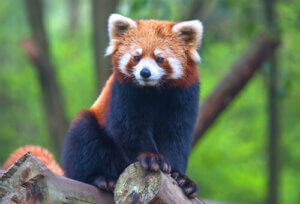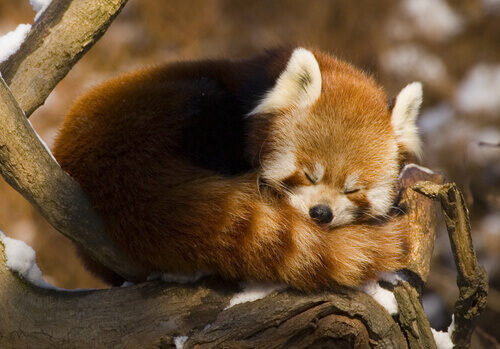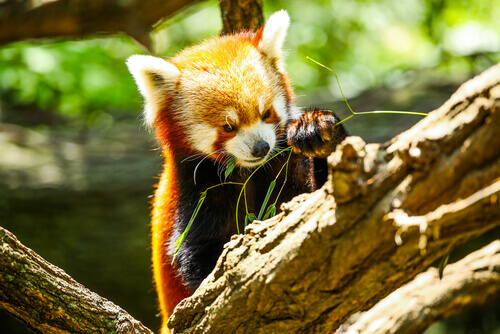Is the Red or Lesser Panda a Bear or a Raccoon?

Overshadowed by the giant panda, the red panda, also known as the lesser panda, is also a mammal typical of Southeast Asia. It’s rather unique, not only due to its color but also because of its long tail and cute face. Learn more about it in this article.
Characteristics and habitat of the lesser panda
This small mammal can measure up to 24 inches, with males weighing about 13 pounds and females about nine. Their fur is reddish-brown, long, and darker underneath. The face is lighter, similar to that of a raccoon, and the ears round, straight, and medium-sized. Finally, the eyes are dark and the nose is black.
The red panda’s main characteristic is a long tail with red rings which allows them to balance in the trees and also cover themselves when they sleep — they usually wrap themselves in it. In addition, their legs are short and black, have retractable claws, and are furry.

The lesser panda is native to Southeast Asia and inhabits the Himalayas, Bhutan, southern Tibet, India, and China. This means they thrive in climates with moderate temperatures, be it mountain or forest ecosystems, with many hollow trees.
There are two subspecies of the lesser panda: the western and the eastern. The former has a lighter face and the latter more pronounced features.
Habits, behavior, and reproduction of the lesser panda
This animal is most active during the night and mainly rests in the branches or hollows of trees during the day. They’re quite sensitive to heat – due to their thick fur – so their activity is low during the hottest hours of the day.
Furthermore, they sleep more at midday in shady places. Also, they don’t do much more than sleep and eat, as their diet is low in calories.
The lesser panda is quite skillful, acrobatic and agile, and can easily move from branch to branch. It’s a solitary animal and only forms groups or pairs during the mating season. It’s pretty quiet the rest of the time and only goes out for food when the sun goes down.
Its predators are the snow panther and the mink and so the panda outruns them by quickly climbing to the top of a tree when they (or a human) are around. Their alternate defense technique is to stand on their hind legs, stick out their sharp claws and confront the danger if they have nowhere to hide. This behavior is rare as they’re quite peaceful and friendly for the most part.
This mammal performs a ritual washing of the front legs and belly and rubs their back with a branch or log before they go on about their daily business.

Diet
The diet of the lesser panda consists of bamboo to a greater extent (just like the giant panda), although they also eat lichen, roots, toadstools, fruit, and grains. They may complete their diet with eggs, insects, and small rodents.
As for reproduction, the lesser panda mates with more than one partner every season, always between mid-January and early March. The cubs are born between June and July, and the female gives birth – after making a kind of nest with leaves and plants – to up to four blind cubs per litter.
We hope you’ve enjoyed this article.
Overshadowed by the giant panda, the red panda, also known as the lesser panda, is also a mammal typical of Southeast Asia. It’s rather unique, not only due to its color but also because of its long tail and cute face. Learn more about it in this article.
Characteristics and habitat of the lesser panda
This small mammal can measure up to 24 inches, with males weighing about 13 pounds and females about nine. Their fur is reddish-brown, long, and darker underneath. The face is lighter, similar to that of a raccoon, and the ears round, straight, and medium-sized. Finally, the eyes are dark and the nose is black.
The red panda’s main characteristic is a long tail with red rings which allows them to balance in the trees and also cover themselves when they sleep — they usually wrap themselves in it. In addition, their legs are short and black, have retractable claws, and are furry.

The lesser panda is native to Southeast Asia and inhabits the Himalayas, Bhutan, southern Tibet, India, and China. This means they thrive in climates with moderate temperatures, be it mountain or forest ecosystems, with many hollow trees.
There are two subspecies of the lesser panda: the western and the eastern. The former has a lighter face and the latter more pronounced features.
Habits, behavior, and reproduction of the lesser panda
This animal is most active during the night and mainly rests in the branches or hollows of trees during the day. They’re quite sensitive to heat – due to their thick fur – so their activity is low during the hottest hours of the day.
Furthermore, they sleep more at midday in shady places. Also, they don’t do much more than sleep and eat, as their diet is low in calories.
The lesser panda is quite skillful, acrobatic and agile, and can easily move from branch to branch. It’s a solitary animal and only forms groups or pairs during the mating season. It’s pretty quiet the rest of the time and only goes out for food when the sun goes down.
Its predators are the snow panther and the mink and so the panda outruns them by quickly climbing to the top of a tree when they (or a human) are around. Their alternate defense technique is to stand on their hind legs, stick out their sharp claws and confront the danger if they have nowhere to hide. This behavior is rare as they’re quite peaceful and friendly for the most part.
This mammal performs a ritual washing of the front legs and belly and rubs their back with a branch or log before they go on about their daily business.

Diet
The diet of the lesser panda consists of bamboo to a greater extent (just like the giant panda), although they also eat lichen, roots, toadstools, fruit, and grains. They may complete their diet with eggs, insects, and small rodents.
As for reproduction, the lesser panda mates with more than one partner every season, always between mid-January and early March. The cubs are born between June and July, and the female gives birth – after making a kind of nest with leaves and plants – to up to four blind cubs per litter.
We hope you’ve enjoyed this article.
This text is provided for informational purposes only and does not replace consultation with a professional. If in doubt, consult your specialist.








